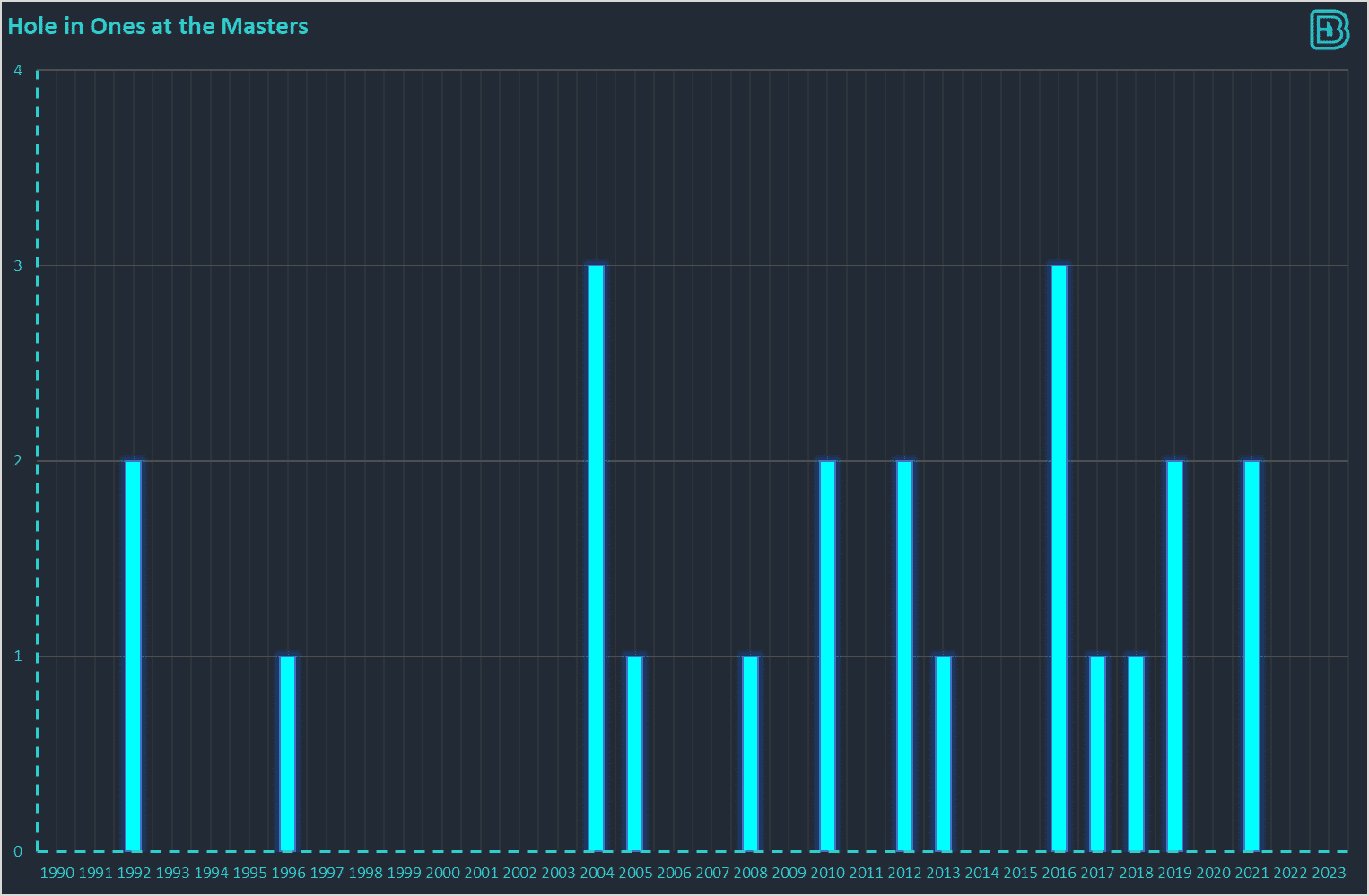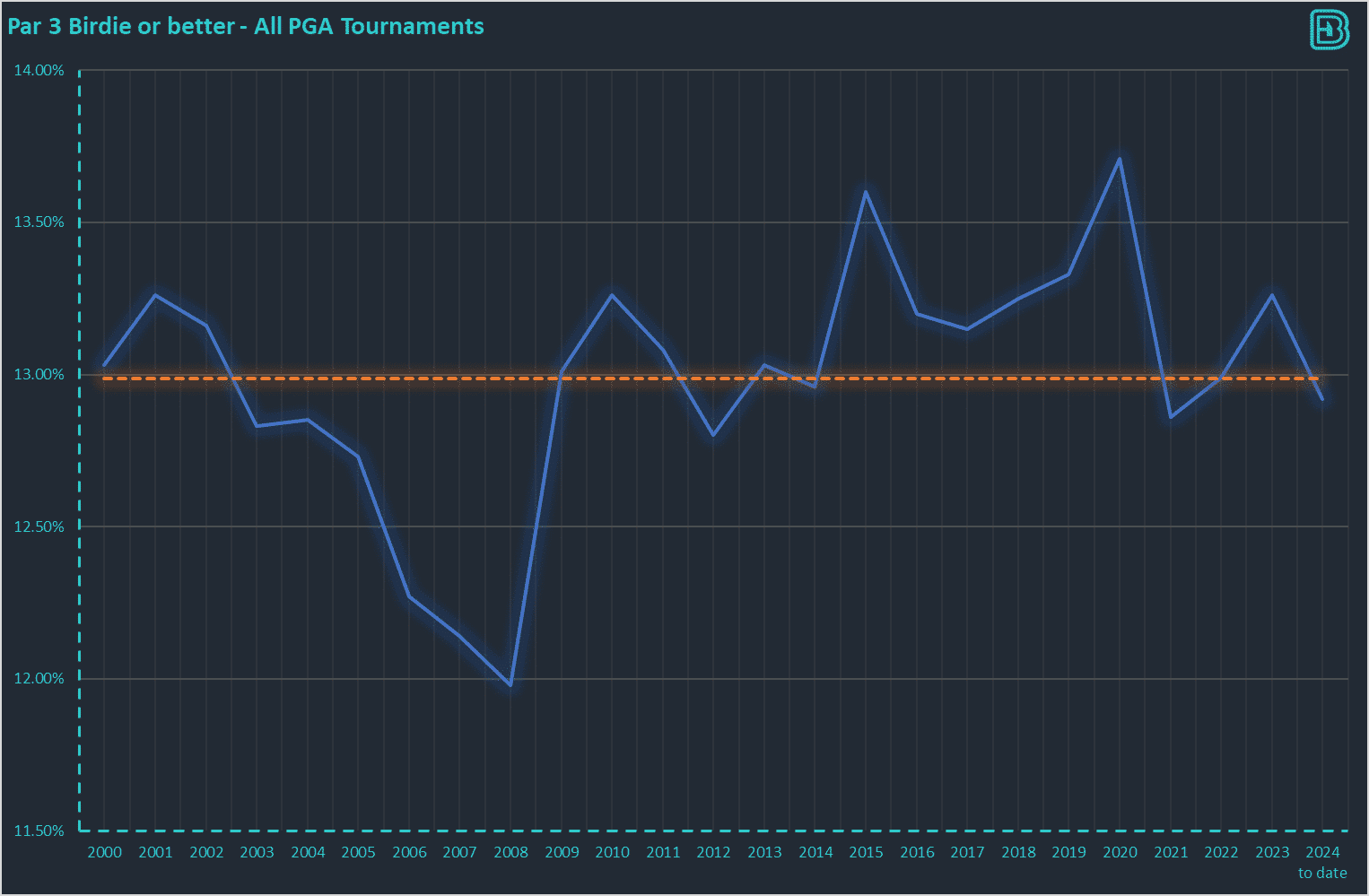Hole In One
Will there be a Hole in One at the Masters this year? This is the historical frequency:
- The average number of holes in one since 2010 has been 1 / year (14 in 14 years).
- The average number of holes in one since 2000 has been 0.79 / year
- The average number of holes in one since 1990 has been 0.68 / year
| Data Range | Holes In One / Year | Yes (odds) | No (Odds) |
|---|---|---|---|
| 2010-2023 | 1.00 | 1.582 | 2.718 |
| 2000-2023 | 0.79 | 1.828 | 2.207 |
| 1990-2023 | 0.65 | 2.099 | 1.910 |
The data is only relevant if it is comparable – if nothing has changed over time, such as players getting better. at Par 3s. To check this we can look at player performance over time, specifically the Par 3 Birdie or Better stat from the PGA:
“Yes Hole in One” is currently available to back at 1.33 to 1.5, so no value.
“No Hole in One” is currently available to back at 2.5-2.8, and this looks like value. The 3.25 at Skybet looks like a great price, and the exchange prices look good at the time of writing. Personally I am looking to back anywhere over 2.4.
Each Way Edges
If you are going to bet on one golf tournament a year then pick the US Masters.
As it is the first of the majors, the bookmakers offer lots of concessional value. In the past 5 places was standard. These days there is a “Battle Of the Places” as bookmakers embark on one-upsmanship; at the time of writing, bet365, skybet, william hill and host of others are 8 places Each Way, Paddy Power, Coral, Ladbrokes and Betfred are 10 places and Betfair Sportsbook are 12 places.
The US Masters is an invitational tournament, and it is a smaller field than usual. Fields of 150-160 are common on the PGA and DP World Tour. The 2024 US Masters has a field of 89. In this field there are a bunch of “special invites” that cannot win. Fred Couples (64) and Vijay Singh (61) were once great, but will not be competitive this weekend. Therefore the field “with a chance of winning” is even smaller than usual, whilst the places paid are greater is larger than usual.
All of this means – we get more value in this tournament than any other.
Does this mean we have a historical profit on the US Masters? We have taken 5-9 players from our tracker, attempting to cover 10-15% of the field, and have tracked their ROI. Note this table is just for fun – a sample size of four tournaments is statistically irrelevant.
| Tournament | Players | Staked | p/l | ROI |
|---|---|---|---|---|
| US Masters 2020 | 5 | £152.00 | -£59.20 | -38.95% |
| US Masters 2021 | 8 | £178.00 | £77.80 | 43.71% |
| US Masters 2022 | 9 | £178.00 | -£43.00 | -24.16% |
| US Masters 2023 | 8 | £190.00 | £72.35 | 38.08% |
In terms of the other majors, the overall ROI is 45.62% (again, the sample size of 17 tournaments is statistically irrelevant). This is slightly higher than our long term ROI of 32% on the golf tracker (results here)
| Major | Staked | p/l | ROI |
|---|---|---|---|
| The Open | £634.00 | £595.60 | 93.94% |
| US Masters | £698.00 | £47.95 | 6.87% |
| US Open | £990.74 | -£68.34 | -6.90% |
| USPGA | £690.00 | £799.17 | 115.82% |
| All Majors (2019-2023) | £3012.74 | £1374.38 | 45.62% |
A breakdown of each individual major shows how much each can swing depending on whether we get a place, a couple of places or the winner:
| Tournament | Players | Staked | p/l | ROI |
|---|---|---|---|---|
| Open Championship 2020 | 10 | £102.00 | -£38.00 | -37.25% |
| Open Championship 2021 | 8 | £178.00 | £362.80 | 203.82% |
| Open Championship 2022 | 8 | £180.00 | £444.80 | 247.11% |
| Open Championship 2023 | 8 | £174.00 | -£174.00 | -100.00% |
| US Open 2019 | 13 | £252.74 | £51.26 | 20.28% |
| US Open 2020 | 9 | £182.00 | £138.40 | 76.04% |
| US Open 2021 | 10 | £206.00 | -£116.00 | -56.31% |
| US Open 2022 | 7 | £202.00 | -£90.00 | -44.55% |
| US Open 2023 | 8 | £148.00 | -£52.00 | -35.14% |
| USPGA Champoinship 2019 | 13 | £238.00 | £758.50 | 318.70% |
| USPGA Championship 2021 | 8 | £140.00 | -£8.33 | -5.95% |
| USPGA Championship 2022 | 8 | £176.00 | £137.00 | 77.84% |
| USPGA Championship 2023 | 8 | £136.00 | -£88.00 | -64.71% |

